23 Feb-2 March 2014. Reading the Lonely Planet descriptions of Quito four months after the fact my reaction is: We were there? Really? How did we miss all that splendour and beauty and things to see and do? Quito for us was something quite different and a bit difficult. It is the second highest capital city in the world, and we’d been suddenly flung, once again, from sea level (in the Amazon) to nearly 3000 metres, and our bodies were objecting. Also we’d read online how very dangerous Ecuador is, and uncharacteristically for us we had believed it, so we were feeling wary. There are many places in the world that are described on the Internet as dangerous, and all kinds of dire warnings are given. Usually we decide that we will discover our own experience and not let ourselves be limited by the experience of others. With Ecuador, for some inexplicable reason, we took the warnings to heart and felt constrained by them. Plus the weather was mostly atrocious.
Quito is surrounded by Andes volcanoes. Located in the Guayllabamba River basin, it also spreads itself over several ridges and valleys. The layout of the city is complex and difficult to navigate. Roads wind down and all along the length on one side of a valley and then up and back along the other. There are few direct routes anywhere. Except in the central old town, a Unesco World Heritage site since 1978.
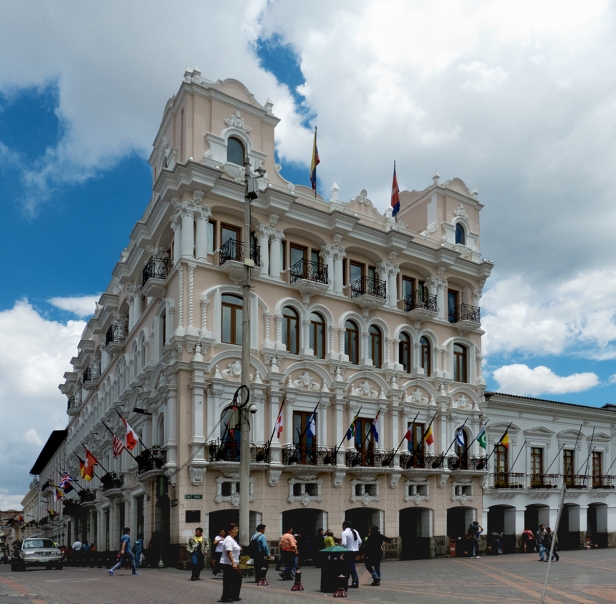


Wandering around this beautiful area of the city: a chance meeting and a chat with a couple of its more captivating residents, who were delighted to be photographed as they sat eating their lunch.
My one enduring memory of Quito from the last time I visited South America, in 1978, is of a heart-stopping golden church, so naturally it was at the top of our list of things to see. The Iglesia de la Compañia de Jesus is one of the best and most important examples of Spanish Baroque architecture in South America. Begun in 1605 it was not completed until 1765. The astonishing gold-leaf-covered altars, and the sheer ornate golden extravagance of the interior took our breath away. It didn’t matter that I’d seen this place before; we walked in and were immediately entranced by its splendor and beauty.
The first photo is a sneaky shot from Don. The second is my photograph of a postcard that was not a good photograph to begin with, but at least gives some idea of the dazzling glory of the place.

Cotapaxi Volcano
From Don’s journal: 28 Feb 2014. Well, we sure didn’t see that coming: a hike over a moonscape from the parking lot at 4,500 meters to the refugio at 4,864 meters and from there up to 4,900 meters before the cold, fog, wind and hail drove us back down again. Our guide, Cristian Daniel Erazo Garcia, who is a mountain climber, set a very slow pace for us, which made the climb possible at all. I’d hoped to make it to 5,000 meters, which is where the Cotopaxi glacier begins, but I just didn’t have it in me to do that last 100 meters, which didn’t sound like much until I looked at the path going up and up ahead of us. It was 100 vertical metres over a winding track, not just 100 metres along the path, and probably would have taken another hour or more. We could both have done with a layer of silk underwear to keep us warm enough. As it was I was just warm enough with what I had on and Ali not quite. On the positive side we made a climb that there is no way we could have done when we first went up to altitude in Bolivia, or even in Puno when we went back there for Candelaria. So that’s good for us: we’re much fitter and more acclimated to the altitude than we were in those locations. After we got back in Cristian’s vehicle my heartbeat became irregular and continued until after I’d had a cup of mate de coca at a café on the way back down the mountain.
We did get high enough to see the glacier.
A new refuge is being built part way up the volcano. Everything needed for construction is hauled up by donkeys.
A brief break in the clouds gave us a view of the valley below.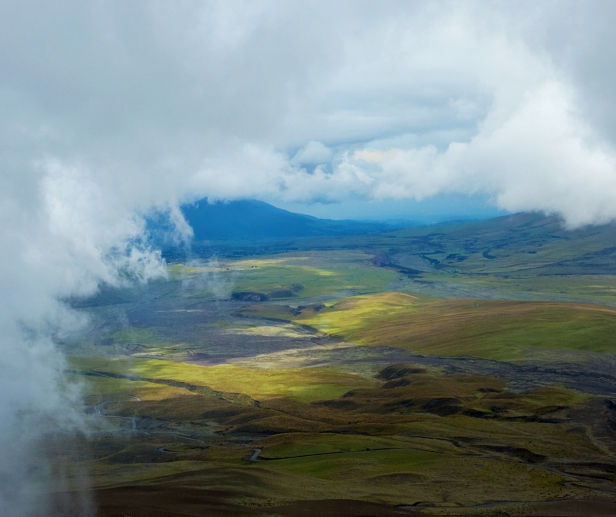
On the way driving up to the starting point of the hike we saw clusters of the Flower of the Andes. It is very particular about altitude, and only grows within a specific range.
Driving down we saw an Andean wolf. Unlike the ubiquitous Flower of the Andes, Andean wolves are quite rare. Cristian said there are only two in the area, and here was one of them hanging out right by the side of the road, seemingly just waiting for us. These kinds of magical encounters with wildlife still, and will always, leave me feeling both mystified and blessed. It was so completely unexpected. We couldn’t believe our luck.
Otavalo
From Don’s journal: 1 March 2014. We began what ended up being a very long day by going to the animal market in Otavalo: a fascinating slice of Ecuadorian life with one llama, one turkey, and masses of goats, cows, sheep, pigs, chickens, rabbits, and guinea pigs for sale. The chickens looked to be having the worst time of it, often being carried around upside down by their feet and then stuffed into a bag once they’d been sold: not much of a life. Though of course the same could just as easily be said for all the other animals there, given their eventual fate.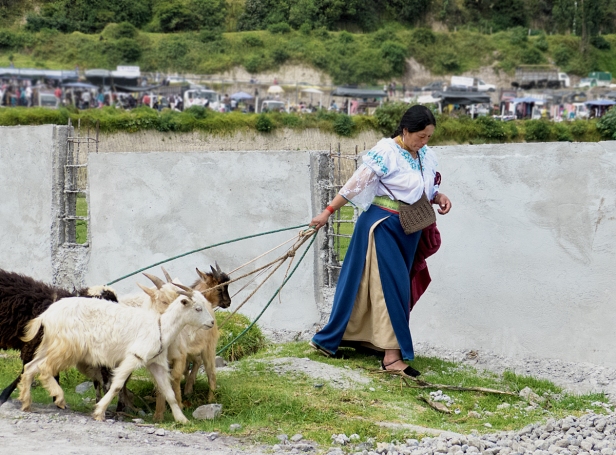


Guinea pigs are a substantial part of the diet of the people of the Andes. They need little food and attention to survive, reproduce rapidly, and provide a protein rich meal. The Andean people both keep guinea pigs as pets, and eat them for dinner, a tradition going back hundreds of years. Just about every restaurant we went to throughout the Andes offered guinea pig on the menu, and we frequently saw them for sale at the markets, both alive, and roasted whole. We might have tried it had it been served in some way disguised, but a whole roast guinea pig sitting on the plate before you was a little more than we could swallow. It’s all a matter of conditioning I suppose.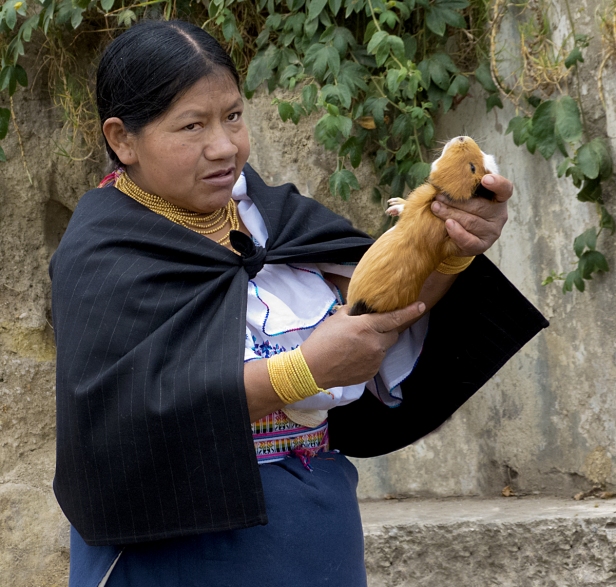
What we did eat was bizcochos. Bizcochos is a Spanish generic term for pastries, but in the small town of Cayambe, just north of Quito, they have perfected a buttery crumbly log-shaped to-die-for shortbread treat that’s typically eaten with cheese, or with dulce de leche. We chose the dulce de leche and ate them fresh, still hot from the oven, dipped in the rich smooth caramel. I think Don thought they were okay. I thought they were one of the most delicious things I’d eaten in all of South America.
From the animal market we drove to the large and very beautiful Cuicocha Crater Lake at the foot of the Cotacachi Volcano and spent some time walking around the lake.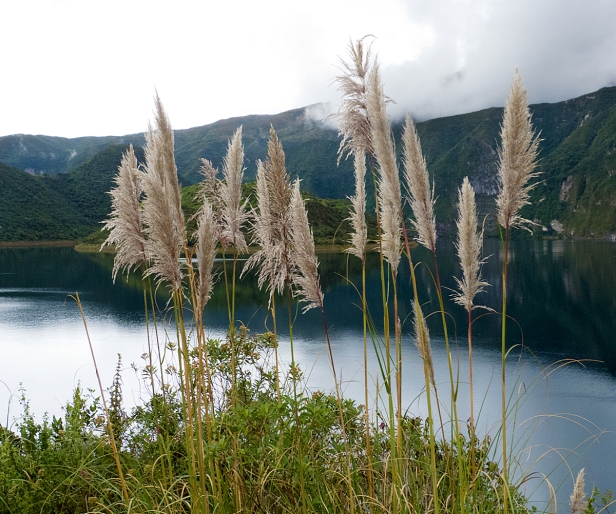
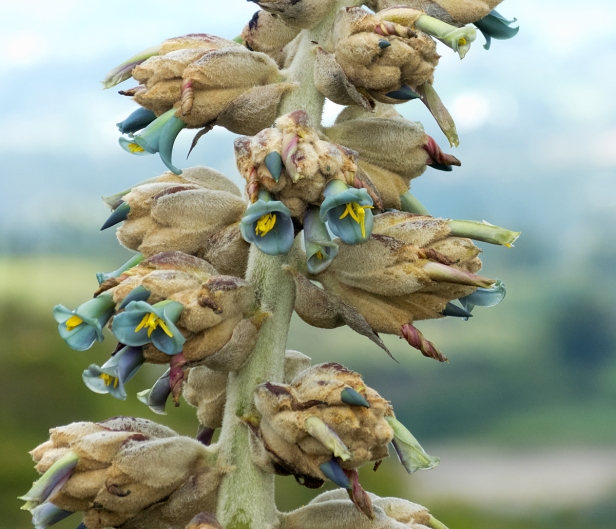
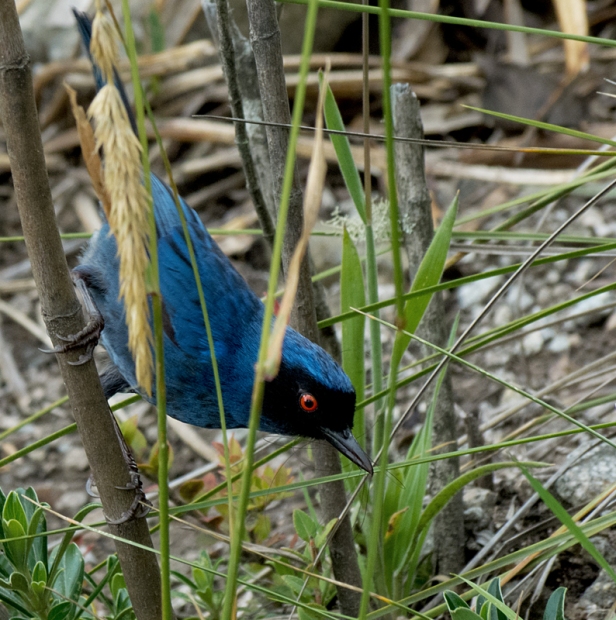
The Otavalo textile and artisan market is huge, filling the entire town square, a main street, and several side streets. Although Otavalo Canton used to be largely a farming area the main industry now is tourism. Crafts are produced in many of the surrounding villages and sold at the market. The area is best known for textiles and weaving of such high quality that they are sold worldwide, and many Otavaleños are quite wealthy. Apparently they are the most prosperous ethnic group in Latin America.
It’s so easy to fall into the trap of thinking that indigenous people in traditional dress in developing countries are by definition quite poor. There’s no doubt that some Otavaleños are, but many of them are quite affluent, and some very wealthy. I’m saying this because I am aware that I do fall into this trap, and the result is a subtle unconscious ‘pigeonholing’. If I look from outside this box a different reality is obvious. They’re not poor they’re just different. One would think this is self-evident, and yet I think we all have unconscious conditioning that affects how we experience the world, and breaking free from it opens up a whole new perception.
Despite the influence of tourism, and the adoption of modern technology, the Otavaleños are proud of their heritage and have retained their traditional customs and dress. We could see the two worlds living side by side.



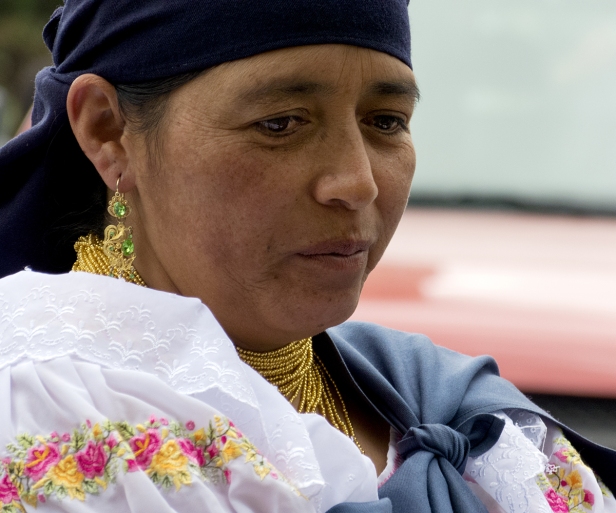


Wandering on from the textiles we came to the fruit and vegetable market on one of the side streets. As always we preferred getting away from the artisan market and discovering where the locals go to shop for shoes and clothes, food and produce.
Around the town of Otavalo


And so our time in Quito came to an end. On March 3rd we flew, with great excitement, to the Galapagos Islands. We expected it to be pretty fabulous, but we really had no idea how utterly amazing it would be. Galapagos Islands next.
All words and images by Alison Louise Armstrong unless otherwise noted
© Alison Louise Armstrong and Adventures in Wonderland – a pilgrimage of the heart, 2010-2015.

I can picture Don sneaking his photo in the church since I am often guilty of the same trick. 🙂 It is a beautiful church. How could you resist?
What no guinea pig? We had one once. My brother Marshall put him in the bathtub, which was where Demon the Black Cat, found him. There was no hesitation about eating guinea pig. Demon barely escaped with her life. I ran ahead of Marshall opening doors so Demon could escape outdoors. She rewarded my by dropping a litter of baby kittens on my feet while I slept. Some reward.
As always, I love the way you capture people. I just have to get over being so shy. Snaggle-tooth had a great grin. And finally the wolf. Wonderful! Both that you saw it and that you captured him so well.
–Curt
LikeLike
I’ve snuck a few photos in my time too 🙂 Got some beauties in churches on Cyprus coming up.
ROFL poor Demon. Clearly misnamed. The guinea pig should have had that name 🙂
The guinea pig, I take it, fought like a banshee for his life. I had no idea they could be so fierce. Cute little things 🙂
You really had a cat give birth on your feet while you slept????? You’ve led an interesting life Curt.
Thanks re the photos. I often, mostly actually, sneak those photos too. Don and I stand face to face and I hold the camera close to my chest and move just out around Don enough to see the subject and then line them up on the screen. I try to make it look like we’re having a really important and intimate conversation. With any luck they don’t notice me at all. Whereas if I hold the camera up and use the view finder they notice right away.
We just loved snaggle-tooth and his lady. One of those situations where we were glad to have some of the local language.
Oh the wolf! Oh what a beautiful moment that was. He was there for a couple of minutes just watching us so I got a few shots.
Alison
LikeLike
I am going to have to try the Alison/Don approach to photographing people. LOL Peggy and I will start practicing. Any excuse, you know. 🙂
Don’t know how well the guinea pig fought since we came on the scene after the battle. Demon was one tough cat, however. We lived next to a graveyard where she spent much of her time, sinking her claws into anything she could get away with. Trophies would then be brought home for display. I was on disposal detail.
Each summer I moved outside and stayed there until weather drove me back in the house. Several animals shared my bed. One morning I woke up surprised to have wet feet. I looked down and there was Demon with her babies. I was awash in afterbirth. 🙂 –Curt
LikeLike
Like you and Peggy need an excuse lol 🙂
Given Demon’s hunting history in the graveyard that guinea pig must have been one fierce little critter!
The saddest thing I had a cat bring home was a frightened, injured, but still alive baby rabbit 😦
Awash in afterbirth – wot an image lol!
LikeLike
I am kind of wishing I had a cat around here to eat a few ground squirrels. There seems to be a plague of them this summer. Our fox has gone missing. I keep catching them in Have-a-heart traps and giving them free transport to the wilderness… which they usually cuss me out for, ungrateful wretches. But I can’t seem to catch enough to make a dent. Peggy and I were finally able to ground squirrel proof her garden. They now run circles around it like indians on the warpath. – Curt
LikeLike
I was there around 20 years ago. It looks to me like folks are wearing much less traditional dress then at that time. It is always such a shame when a culture gives up the traditional costume in favor of cheap chinese imports–or imports from our thrift stores. That is happening in Central America as well.
I do love that photo of the woman in traditional dress looking at her smart phone-
LikeLike
I agree it’s a shame when a culture gives up on their traditional dress. All over South America and Southeast Asia we found that most of the men and the young were wearing ‘western dress’ but the women, especially the older women, are still wearing traditional. Which makes me think that in a few generations even that will be gone. In Otavalo I thought there was a higher percentage of people generally still in traditional dress.
It always seems incongruous to me to see them with their phones, and yet why? Before the invention of cell phones the vast majority of people in developing countries had no phones at all so it must be a fabulous advancement for them. I can’t count the number of photos I have of Buddhist monks talking on their cell phones 🙂
LikeLike
Enjoyable post and photos, as always!
LikeLike
Thanks so much Lexie. Just had a poke around your lovely blog – I see you’ve had a few adventures yourself 🙂
Alison
LikeLike
So many beautiful faces in these photos. I think if you take the facial expressions of each of those two captivating residents (one of the first photos with people in them), and then apply the Pythagorean Theorem to them to calculate the hypotenuse, you will have the meaning of Life. You will also have an amazing new filter for Photoshop, but by then it won’t matter. I love the idea of glaciers in proximity to volcanoes. And I’m with you on the guinea pig dissection at the dinner table. It seems like a dish you need to try with locals first… 🙂
Michael
LikeLike
Your mind is so inventive – Pythagorian Theorem? Really? Only you would have thought of that. It’s a lovely image – that within these two seemingly destitute people is the meaning of life. And of course it is. They were so alive and full of sweet joy.
Whole roast guinea pig dinner eeewwwww. I probably would have tried guinea pig pie or guinea pig stew.
LikeLike
Yes. Really.
It was either that or the Associative Law of Beings, which states that although you can’t add any two beings together and make any sense of the result, if two beings share a Purpose, then you have the same power as all beings. This Law works in all cases except for tug-of-war.
Michael
LikeLike
Chuckle. Good thing Don and I are not in a tug-of-war 🙂
LikeLike
Utterly fascinating post & photos!
LikeLike
Thank you so much Cindy. Glad you enjoyed it.
Alison
LikeLike
Your photos captivating! -M
LikeLike
Thanks so much Maureen. I so enjoy the whole process of capturing the moment, trying to get the essence of a place.
Alison
LikeLike
Beautiful pictures. I totally connect with what you were saying about the change from high altitude to low altitude. We spent a summer in peru and experienced the same thing. My sister got so ill! I literally thought she was dieing…traveling teaches us so much.
LikeLike
Some people have a really hard time adjusting to altitude. Sounds like your sister was one of them. And people have died from it. We had kind of midrange normal reactions I think – it troubled us, mainly low energy, but we were never really sick from it. Isn’t Peru fabulous?!
LikeLike
Yeah I loved Peru. I was in Arequipa for three months as a volunteer in a children’s home and then we traveled after and it was great. I miss Coca tea. We were there during transport strikes and so to avoid protesters who stopped buses we had to take the long trip from Arequipa to Cusco which brought us from high altitude to low to high again all in one day. Luckily her illness only lasted a day but it was intense.
LikeLike
I love the many beautiful ladies’ blouses embellished with lace. We save lace for special occasion clothing, in Quito lace appears to be worn to bring home the goats or bead necklaces. Nice bit of cultural photography there, Alison.
And… I am primed for the Galapagos, girlfriend!
LikeLike
Thank you so much Pam. Aren’t those blouses beautiful? And yes, made for everyday wear. I can’t imagine it. I would only wear something special like that if I was getting all dressed up.
Um, the next post will probably be one in the ‘This Nomadic Life’ series, but Galapagos very soon I promise. I’ve started choosing photos.
Alison
LikeLike
I actually enjoy your reflective interludes, plus Don’s thoughts about travel [and life] as well. But, after that, I’m Charles Darwin …
LikeLike
That is so cool that you got to see the wolf! Wildlife encounters are one of the many reasons why I travel 🙂
LikeLike
Oh the wolf was magic! True magic. We were possibly the only people that day who got to see him – and there he was, right by the side of the road and in no hurry to run away. Magic!
Alison
LikeLike
Love it 🙂
LikeLike
I was in Quito a few months after you and was deeply touched by the landscape. There was something magical about being in the rounded bowl of green mountains at an altitude of 2800 meters. I felt like I was being held up to god by the hands of angels. My local host told me that the word Quito means ‘face of god’ so I guess I am not the only one who had that lovely feeling.
LikeLike
Oh how lovely. I wish we’d been able to feel that. I think we were a bit exhausted at the time from nearly 3 weeks nonstop at Candelaria and in the Amazon.
And as I write this the thought has come that overall India and Southeast Asia were both much more spiritual experiences than South America which had something different to offer us. We never did get the feel for Quito, but I’m so happy for you that you could connect with it. Did you get out and about at all?
Why are you Ruh? What happened to the t? 🙂
Ali xox
LikeLike
Forgot to say that we discovered too late that there is a 4 hour hike around Cuicocha Lake. It was so beautiful there. If we’d known we’d have done that hike.
LikeLike
Ohhh I was once in Quito on my way to the Galapagos islands! I spend a few days there and i didnt find it dangereous as people say. My time there was amazing! The people were really nice and the city is really cheap! I hope to go there again and visit the Cotopax because I didnt have time to go there last time 😃
LikeLike
Hi Allane, nice to meet you. I’ve been having a look around your lovely blog. We didn’t make it to Brazil 😦
We didn’t find Quito dangerous either. It was great. There’s so much nonsense on the net about how dangerous some places are. I think that if you pay attention to your stuff, and use common sense, most places are fine, and if you approach people with kindness and a smile they respond in the same way.
Cotapaxi was fabulous, but I do hope you get a sunny day!
LikeLike
Ownnn I hope you can make it to Brazil sometime!! The only problem is that Brazil is too big and there is a lot to see from south to north!! But if you ever go let me know and I will give you some tips 🙂
Yes, I agree with you…and also it really depends on the person’s experience and own perspective.
And about Cotopaxi, the bad weather was the main reason why I didnt make it there…so I ended up not going, maybe next time!! 🙂
LikeLike
Brings back some great memories. I was in Quito for about 3 months teaching English and managed a weekend trip to Otavalo. Had a great time, apart from a small incident when I arrived. I’d just got off the bus and was walking down to the main square when I heard a dog howling in pain. I turned round to see a car whizzing round a small square with a dog trapped in the door by it’s ear (not by accident I have to add). Very unpleasant and disturbing, especially as half the locals were laughing about it.
Apart from that, and some mysterious chicken feet in my soup, I found Otavalo a delightful little town and enjoyed doing my Christmas shopping there, even if the glass paintings I bought got smashed on the journey home.
Thanks for the memories…
LikeLike
Wow, the dog thing. Sounds horrific. I’m cringing just thinking about it.
I’ll bet your experience of Quito, having 3 months there and meeting many Quiteños, was quite different from ours. Still I think we did manage to find some of the beauty there, and in Otavalo and in the surrounding countryside.
Alison
LikeLike
Another fantastic post, Quito looks amazing. The contrast of the volcano to the glacier looks surreal. Definitely putting this one on the list!
LikeLike
Thanks so much Tommy. Oh I would recommend this on your list. I think if we’d had a little more time to adjust to the altitude, and a bright sunny day our Cotapaxi climb would have been even more special. We’re still glad we did it.
And Quito is definitely worth a visit even if we were feeling a bit cramped and weary. Apparently many other people have had a wonderful time there 🙂
LikeLike
Are u going to the jazz fest by any chance? Maybe I’ll see u there! I’ll be hanging out with my daughter who will be at the Kootenay lack tourism tent. Jacquie
LikeLike
We just put it on our calendar – so we’ll wander down and say hello. It will be lovely t see you again
Alison
xo
LikeLike
The Kootenay lack tourism tent lol. Nice typo Jacquie 🙂
(I’m guessing it was that damn atuocorrect got ya)
LikeLike
Great post – loved the photos and your fascinating narrative!
LikeLike
Thanks so much Jo Ann.
LikeLike
Great post – brings back lots of memories of Ecuador…
LikeLike
Thanks Shirley. The highlight of Ecuador for us was Galapagos of course, but we also spent 2 weeks in/around Cuenca and that was pretty neat too.
Was it on your blog that I read about the Devil’s Nose train ride?
Alison
LikeLike
Sneaking photo’s in churches and of unaware locals–now I know you two are rebels! Please keep it up:)
LikeLike
Rebels? Us? Say it aint so! But thanks, we will – keep it up. Grin.
Alison
LikeLike
Beautiful photos! Thanks for virtual tour! Bye. Kamila
LikeLike
Thank you so much Kamila. I’m glad you enjoyed it.
Alison
LikeLike
I used to have pet guinea pigs and would never be able to eat them the cheeky little fellas. By the way, watch yourself at altitude, trust me I know.
LikeLike
Yeah, eating guinea pigs eeeewwwwwww, especially if they’ve previously been pets. I guess you do know a thing or two about altitude 🙂
We were fine with the altitude – a bit low energy, and at the highest places a bit spacey, but nothing serious
LikeLike
Such beautiful, rugged terrain.
You are having quite an adventurous life in your lifetime! Surely, this is exactly what life is for. Thanks so much for sharing!
LikeLike
Thanks Mary, you’re welcome. Yes the terrain was fabulous – and unexpected, though I don’t know why since we knew we were going up a volcano.
We love being adventurous. And then we love resting 🙂
LikeLike
Sounds amazing! Lucky you for seeing the wolf too… the portrait images are really great too…. makes me want to pack my bags and hop on a flight to Ecuador… really enjoying reading about your adventures by the way. 🙂
LikeLike
Thanks so much. Glad you’re enjoying the blog. The wolf was such a magic moment. We were very lucky. Ecuador’s worth visiting for sure – hope on a flight 🙂
Alison
LikeLike
More incredible shots and experiences. Spotting the wolf must have been so incredible! That church is one of the nicest I’ve ever seen, how completely beautiful from top to bottom.
Your street shots are just incredible. Yet again, you really capture these perfect moments that just highlight the culture and surroundings so beautifully!
I can’t wait to hear about the Galapagos!! 🙂
~ Andrea ❤
LikeLike
Thanks so much Andrea. The wolf was magic! As was the church – hard to believe a place of such beauty exists. We were in awe.
I do love to photograph the people just going about their daily lives. That’s magic too.
Alison ❤
LikeLike
Hi Alison and Don. I leave July 2 for my journey! If I wasn’t so busy, I’d be excited! I will continue to follow your blog and, if you are following mine, perhaps we’ll find ourselves in the same place sometime this coming year. I would love to meet you.
love.jane.
plainsweetjane
LikeLike
Hi Jane – would love to meet you too. And yes we are following your blog. Africa in 3 days! How exciting! We will be in Vancouver until end November, then some south Pacific Island, then Canberra for Christmas, mid Jan NZ for a few weeks, back to Oz, April-May and perhaps also June in ? (ideas are Indonesia Philppines Japan). If you’re going our way at all let us know.
Have a fabulous awesome time.
Alison ❤
LikeLike
Oz? Off to see the wizard?
LikeLike
Australia 🙂
LikeLike
Incredible! I’m so impressed with you both climbing that far up Cotopaxi. I know from experience how brutal that altitude can be, making it difficult to just go up a flight of stairs in Quito. Hopefully one day, we’ll be able to take the kids up when they are a little older! These photos are just fabulous by the way, I really love the flowers and the portraits 🙂
LikeLiked by 1 person
Thanks Stephanie. Cotopaxi was a bit of a slog, but really worth it – for the brief views, for the wolf, and for the sense of achievement. It’s always better to be outside hiking that lazing around indoors. Well almost always 🙂
Definitely worth the effort when the kids are a little bigger. You’re bound to be much more acclimated to the altitude than we were.
Alison
LikeLiked by 1 person
I see I made a deep and insightful comment here (not!), way back when I had just started blogging. So interesting to read this now, just after my own return from Ecuador. So many of our experiences in Quito and on Cotopaxi were similar! I think the wolf sighting would have redeemed any kind of weather disaster on Cotopaxi for me (but I’m sure I would not have captured him as well as you did anyway!).
LikeLike